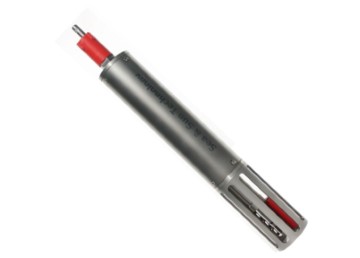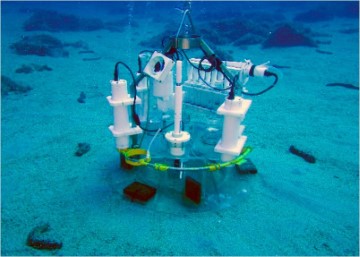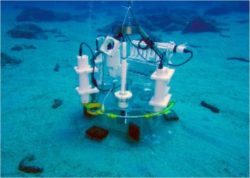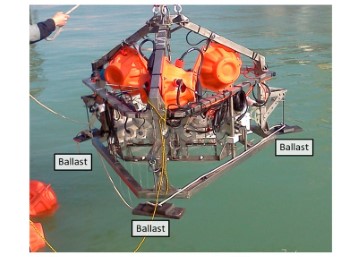ES-O2-DW
measure dissolved oxygen, EC, temperature and depth to 6000m
overview
- Robust, high quality, galvanic style dissolved oxygen sensors
- Rated to ocean depths of 6000m
- Integrate with your existing CTD, AUV, or similar underwater system
- Measure DO, EC, temperature and water depth in a single sensing device
- Calibrated, low maintenance, scientific grade sensor
 available models
available models
ES-O2-DW: Measure DO only
ES-O2-CTD: Measure DO, EC, Temperature and Depth in a single sensing device
This membrane-covered dissolved oxygen sensor has been developed above all for long-term monitoring but also for slow profiling.
The O2-sensor follows the amperometric principle. The anode is formed by a silver tube in contact with a halogen containing electrolyte within the sensor. The cathode comprises a glass body in which a platinum wire is arranged as the cathode. At the rounded end of the sensor a removable hood is situated by which a gas-permeable membrane is held in place.
The sensor can be used in salt water, lakes and rivers (fresh or charged water).
A multi-core 4-wire sea-cable is used for power supply and data acquisition. A power supply of 9...30 VDC is used as current source for the sensor. The sensor consists of a titanium made pressure tube, oxygen sensor head with exchangeable electrolyte and membrane (for several applications), sensor cap and titanium/neoprene underwater-connector (optional with locking sleeves). A pressure resistance of 2000 or 6000 dbar is warranted. The integrated electronic board is equipped with a Lithium cell for the continuous polarisation of the sensor. When the sensor is connected to an external power supply, than the continuous polarisation of the sensor is disconnected by an integrated switch.
The oxygen sensor has been designed to give different performances depending on the membranes used. The sensor normally uses two membranes, the inner membrane for measurement and the outer membrane for protection.
 more details
more details
The main operating principles of the oxygen microsensor are diffusion of oxygen through a porous membrane where the oxygen molecules undergo an electrochemical reaction to create an electrical signal. This type of sensor is also known as a galvanic or Clark-type microsensor.
The ES-O2-SW operates via a difference in partial pressure between the environment being measured and inside the sensor. Oxygen passes through the membrane via diffusion.
The membrane is only pervious to gases, so that liquids, ions and solids are not able to reach the inner electrolyte of the sensor. Inside the sensor contains a buffered solution and 3 electrodes. The electrode materials are selected carefully to realize a self polarization for requested electrochemical reduction of oxygen at the working electrode surface. Therefore essential shorter times for putting into operation after switching on are observed compared with the normally delivered amperometric sensors.
If the O2 passes now the membrane, the oxygen is transported by diffusion to the working electrode followed by the electrochemically reduction of the O2. This causes a current depending on the oxygen partial pressure/oxygen concentration of the analyte. The observed very small current within a range of some hundred picoamperes is converted into a voltage of 0...5 Volt (main working range: 0...1,500 mV) inside the integrated electronic device of the sensor. Besides, the current flow in the galvanic sensor leads to a rapid decrease of the analyte inside the sensor resulting in very fast response times. This is also observed, if a rapid change from high to very low concentration levels is necessary.
All electrochemically working oxygen sensors have to be combined with a temperature sensor.
When ordering a complete submersible probe system, the temperature measurement and the temperature correction of the sensor signal is already included. If measurements in a flow through system are required, special temperature sensors for the integration in flow through cells are offered.
When measuring in opened vessels or beakers in the laboratory, the customers have to realize the temperature measurement themselves. If a sensor with temperature compensation data is ordered, the temperature correction of the signal is very easy by means of a factor or for more accurate measurements by means of a mathematical formula.
specifications
| feature | specification |
|---|---|
| Measuring Principle | amperometric, membrane-covered sensor |
| Measuring Range | 0 ... 150% saturation, 0...20 mg/l |
| Measurement Accuracy | ±2% sat., drift: 0.1 to 0.3 ppm/week |
| Response Time | t63%: 10 seconds |
| Resolution | 0.1% saturation |
| Power Supply | 9 ... 30 VDC (others on request) |
| Signal Output | 0 ... + 5 VDC (others on request) |
| Sensor Dimensions | measurement tip: 25um | Diameter: 25±0.3 mm (2,000 m), 29.5 ±0.3 mm (6,000 m); |
| Weight in Air | 260 g |
| Connector | Subconn BH-4-M Titanium (others on request) |
| Housing Materials | titanium, POM |
| Power Consumption | 55 ±10 nA at 12 V DC |
manuals & docs
- ES-O2-CTD Oxygen Sensor
- ES-O2-DW Deep Sea Oxygen Sensor Datasheet
- ES-O2-SW Oxygen Microsensor Overview
related products
- Our complete range of dissolved gas sensors
- Deep sea pH electrode
- Dissolved oxygen sensors
- Dissolved carbon dioxide



